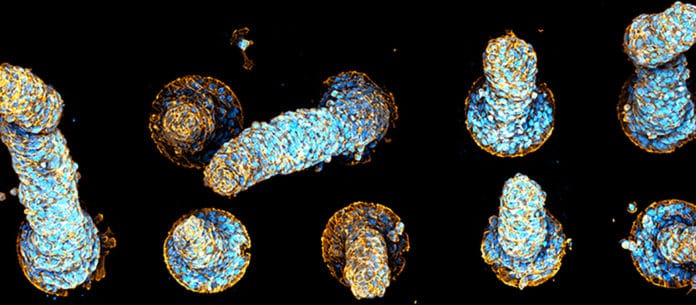The human body has many levels of structural organization. Each organ and tissue has its peculiar shape. But, the different shapes of our organs and tissues generated remains poorly understood.
To answer this question, a team from the University of Geneva (UNIGE), Switzerland, tested the ability of cellular tissues to spontaneously self-model. Scientists forced muscle cells to reproduce simple shapes in vitro spontaneously.
These muscle cells are capable of contracting. Their rod shape allows them to align themselves.
A circular motion is created around a vortex – called a topological defect – which, by orienting the cells, allows them to join forces, deforming the cell monolayer into a protrusion, a structure commonly observed in embryo development.
The collective rotational forces of the cells that create a tornado-like effect maintains this cylindrical protrusion. This tornado-like effect has a simple mechanism of spontaneous morphogenesis, dictated by the unique properties of multicellular assemblies.
Aurélien Roux, a professor in the Department of Biochemistry at the UNIGE Faculty of Science, said, “When the cells are placed on a flat surface, they align themselves and form structures similar to a field of wheat where the wind has passed through: there is an overall order with sudden changes in direction at punctual places. These changes in direction are called ‘topological defects’: they represent the places where the physical forces exerted on the cells are either very weak or, on the contrary, immense.”
To understand the role of topological defects, scientists grew cells on adhesion discs.
Aurélien Roux said, “This involves confining our muscle cells to a surface surrounded by repulsive molecules that force them to form a circle. The cells quickly start to rotate together to form an ordered spiral. We can see a spontaneous movement of the cells, like when a crowd is forced to walk around a room and ends up going in the same direction for ease.”
Karsten Kruse said, “Thus ordered, only one topological defect remains at the center of the circle. The spiral, which concentrates the cellular forces in its center, accumulates the newly formed cells, thereby cell division. Thus, the spiral will gradually become a vortex, creating a protrusion in the middle of the disc.”
“And this protrusion can reach up to half a millimeter, which is enormous for a base that is not a hundredth of a millimeter in size. Therefore, the Geneva team is observing a real little 3D cellular tornado that is spinning around.”
Scientists found that the muscle cells spontaneously formed tornado-like structures, which resemble the structures observed in the embryo’s development.
Aurélien Roux said, “This spontaneous self-organization without biochemical regulation could be the initial stage in the formation of protrusions in the embryo.”
“It is indeed the topological defects that control the organization of cells and determine the shape they will adopt. “
Karsten Kruse said, “Finally, our study shows that cells do not escape the laws of physics but, subjected to the same constraints as all materials, they exploit them to concentrate their forces and create shapes only seen in living organisms.”
Journal Reference:
- Guillaume, P., Blanch-Mercader, C., Pernollet, G. et al. Integer topological defects organize stresses driving tissue morphogenesis. Nat. Mater. (2022). DOI: 10.1038/s41563-022-01194-5
